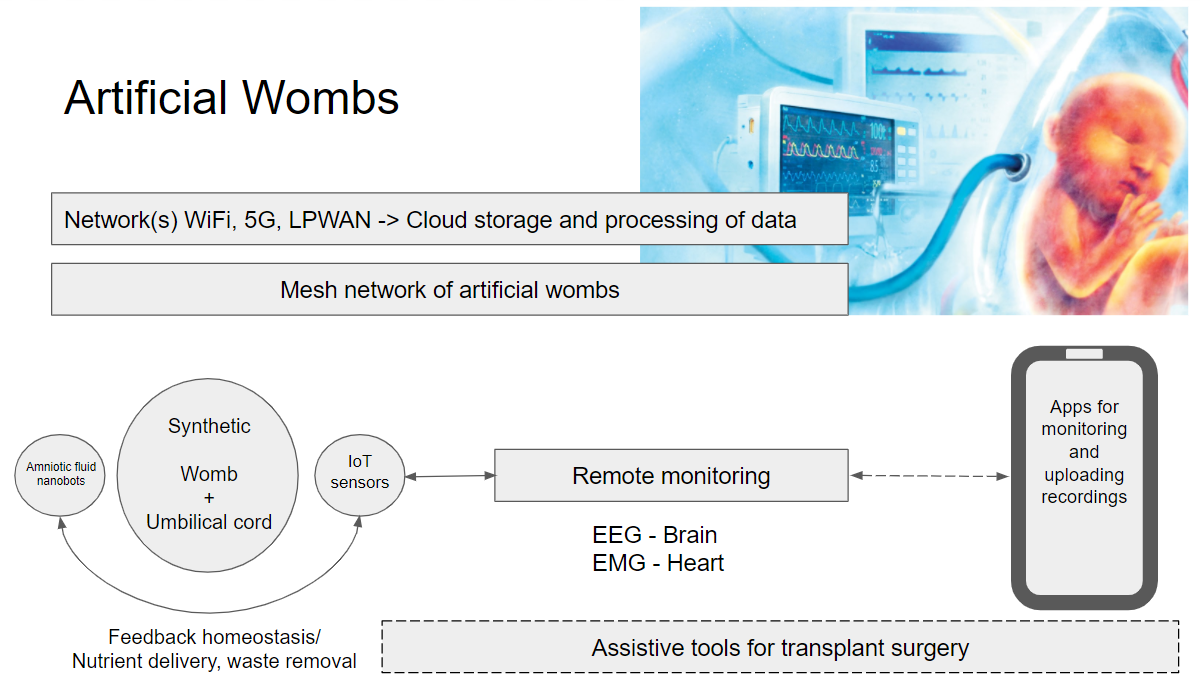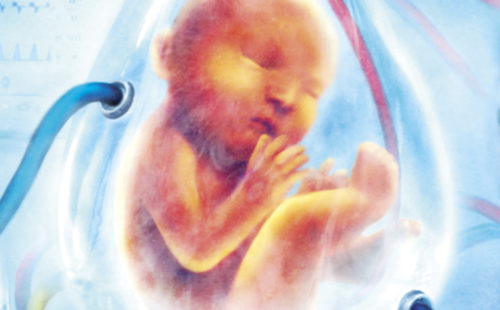
latest
Getting Real: Artificial Wombs

Dr Peter Bloomfield
This month’s story “All I Asked For” by Anne Charnock is a thought-provoking piece exploring the concept of artificial wombs and ex vivo childbirth. The narrator in her story has, with some uncertainty, elected to transplant her unborn child to an artificial womb, or “baby-bag”, in anticipation of possible complications arising later in her pregnancy.
In this article, I will focus on the technology and science at play and considerations for implementation. This area will be of growing importance, as global fertility rates have reduced and are predicted to decline further. Indeed the global fertility market is valued at $14.8 billion in 2019 and Assisted Reproductive Technology (AFT) is predicted to grow to >$45 billion in the next five years.
The concept of artificial wombs for growing and carrying a foetus to term (ectogenesis) has been around for many years, with the first patent being filed in 1954 by Emanuel Greenberg. In science fiction, The Matrix probably demonstrates the most memorable artificial womb.
A viable version of the technology has been demonstrated with the incubation of lambs, which, similar to this month’s story, were incubated in a “biobag”. The line between an artificial womb and an incubator is blurred but the difference appears to be where the embryo develops in the early weeks. If a foetus is first developed in utero and then transplanted this would be a form of incubation. However, if these initial weeks of development occur ex vivo, then this would be a fully artificial womb scenario.
In the short story, the child has been transplanted at 22 weeks, by pre-emptive caesarean, which would fit with incubation. The obstetrician in the story comments, “one day most babies would gestate from conception in an artificial womb”, so even in the story, the early gestation period occurs in utero.
The sensor technology deployed would need to be extremely sensitive and accurate, some thermal IoT (Internet of Things) sensors currently on the market are accurate to less than half a degree; there would likely be many more sensors around, and inside, the womb and umbilical cord.
There are many references in the short story to the physical experience of pregnancy, however, there is little technology proposed for simulating that experience. You feel greatly for the mother, not being able to develop that in utero bond with her child. The psychological and mental health impacts of artificial gestation would need to be carefully considered. To help a mother or parent feel connected to the baby, haptic wearable technology may provide some of the sensations of quickening movements (kicking and fidgeting) to improve a sense of physical connection. The mechanism of prenatal bonding is important, although not well understood at present and it would need to be one of the considerations if artificial womb technology were to become mainstream.
There are other physical characteristics of pregnancy that would be much harder to replicate. For example, bi-directional transfer and integration of cells (known as microchimerism) between mother and child occurs in a range of tissues, including the brain. This is thought to have long term health implications for the mother, some beneficial, some detrimental.
As we are seeing, the science of gestation and birth is highly complex – many mechanisms and evolutionary traits in human development are still not fully understood. There are also concerns that, compared to other mammalian species, humans have a pretty difficult time giving birth and raising a newborn. This is, in part, due to walking upright and needing to birth a comparatively larger head and brain, known as “The Obstetrical Dilemma”. This has resulted in some controversy and debate since it was proposed in 1960, with researchers offering updated and more nuanced ideas.
While some of these difficulties may make the “baby-bag” more attractive, simulating the environment and conditions is risky. There are some areas where the simulation in the story, and understanding the purpose of those simulations, would need developing further. For example, the simulation of walking and movement of the mother; we don’t currently know how much physical activity affects an unborn child – a recent review demonstrated that there was not enough research evidence to determine the impact of exercise beyond the mother’s health. There has also been much debate about the long term implications of birth by caesarean section, and the “bag-cutting ceremony” appears to be a form of caesarean section. These are just two areas for consideration, but there are many more to explore, before we get to ethical questions and the question of “should this be done?”.
Since the structure of DNA was discovered in 1963, there have been astonishing advances in technology for sequencing, analysing and manipulating the genetic makeup of a range of species. More than 3,500 complex species have had their genome sequenced and researchers are expanding this rapidly, with an ambition to grow this to a library of 1.5 million species through the Earth BioGenome Project. With so much genetic technology available, researchers and clinicians have been able to prevent certain heritable illnesses, including by having three-parent babies. With the invention of simple techniques such as CRISPR-Cas9, editing the genome is easier than ever, but this raises a range of ethical concerns, particularly around “designer babies”. This debate was accelerated when a group of researchers announced they had created a pair of twins with a CRISPR-Cas9 edited genome. The researchers were subsequently investigated and sentenced for illegal medical practice. This experiment was to prevent HIV transmission to the children; however, it raises many questions around what can now be done and how different traits could very easily be manipulated to create a “designer baby”. As this technology develops new medical specialties will emerge – perhaps we will have genetic obstetric surgeons?
There are many layers of technology and devices here. If we think purely of the “baby-bag”, this would likely be classified as a controlled medical device (neonatal incubators are currently class IIb medical devices under EU legislation). However, as more technology is brought together it is unclear what is a medical device and what is a well-being or lifestyle product. For the incubation of the lamb in the US, it was a local research facility committee that approved the experiments, however, if this were to transition to human primary care, there would be a significant amount of approval and regulation required. In the UK, there are very strict regulations around surgical procedures in an experimental setting, with researchers being registered by procedure. In a clinical setting, physicians require Membership of the Royal College of Surgeons (MRCS) and supervised training for each new procedure. The surgery performed in the story may well be aided and improved by many forms of technology, some of which are already being successfully deployed.
Reading All I Asked For was fascinating and I have enjoyed researching the science and technology around it. While certain elements of the story remain science fiction, and will do for some time, I was surprised how close to the present some of the concepts are. Many of the most interesting discussions I have had about this story have been outside of the scientific and technical domain. It has been great to see some of the comments and feedback since the story was released. It is now a few weeks since I first read Anne’s story and I keep revisiting the “silent bay”, which I’m sure will stay with others too.
My personal conversations with friends, family and colleagues have brought up many areas we have not been able to explore here. The type of healthcare system which this could be a part of, different societal and rights implications and health inequalities. The implications for parents, the workplace and emotional relationships between all parties involved are significant. Considering scientific and technological details in a vacuum is rarely helpful or ethical, and the passionate discussions I’ve experienced on this topic highlight that this short exploration is a small start on a much larger conversation needed, especially where so much of the technology has already been trialled in experimental settings, at times with major consequences.


